Having worked in Champagne in 1998 and made sparkling in Australia under a JV with Champagne Devaux, I can understand why people could feel like they’re on a roller coaster ride when it comes to Champagne.
The 1998 Vintage in Champagne brought pain and acid guts at one extreme, and, inspiration and yumminess at the other. Instead of watching the Crows win a second flag on the trot and experiencing the cold showers Melbourne endured when Esso’s Longford Gas Plant Exploded, I saw the inner working of Champagne, from the Machine hidden from starry-eyed tourists to the Artisan striving for excellence.
Champagne has established a mythical status as the Celebration Drink. I reckon it takes us back to the elation we felt blowing bubble in our childhood … or still do today in my case. Champagne is an incredible contradiction, kinda like comparing Milli Vanilli to the Three Tenors, extremes in quality. With one you get pleasure, the other pain! By spending a Truck Load of marketing $$, they still manage to get enviable prices for their Milli Vanilli range.
If you’re into Lip Syncing, there are the Gargantuan Champagne Houses producing, unfathomable volumes of Champagne. This is all about making wine by the numbers. All science no art, just a recipe. 500L/Tonne Free Run, 150L/Tonne Pressings, add a bottle of this prepared mix now, a different one later, then when it’s finished fermenting throw it all in an Austin Powers sized “1 million” litre tanks, and tirage it (chucking it in a bottle with a little sugar and yeast for a second fermentation to give it the bubble) within 60 days of harvest.
It’s the only region in the world that manages to yield 10T/Acre or more and convert it into such a high-priced beverage. I love the Appellation System that controls yield at the winery, but, not in the vineyard. Grower can yield as high as they want, dilute all the yumminess, as long as they only drop the permitted amount of fruit off at the winery gate. If you spend a bit of time in the region, around vintage in a big year you’ll notice, the number of trucks on the Motorways that are able to conceal a load of grapes goes through the roof. Now that’s an interesting quality control system! I wonder if the French apply the same rules to nuclear reactors. BOOM!
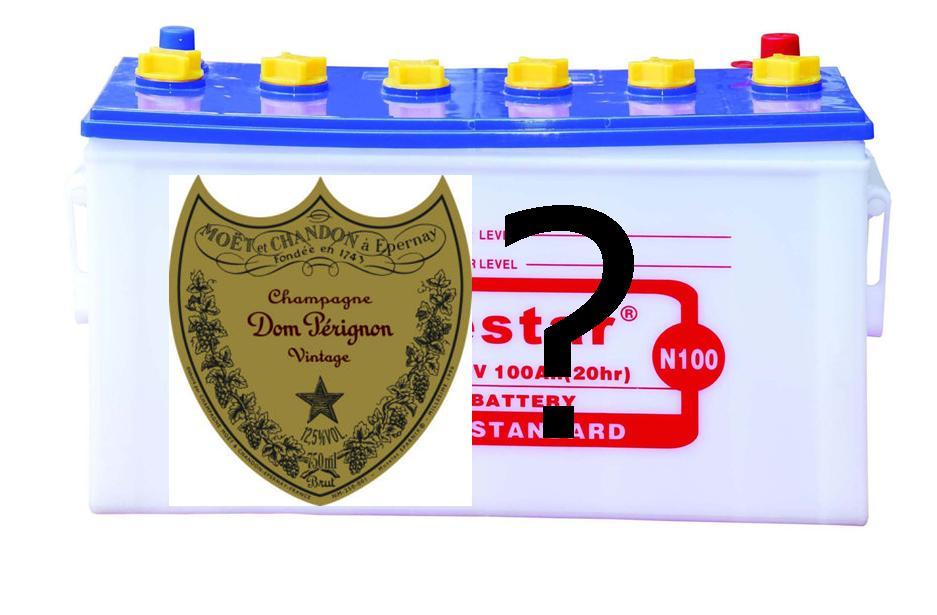
Champagne or Battery Acid
I can’t remember who I first heard say that “Champagne is just Battery Acid with Bubbles and Alcohol in it”. At the low-end, I’d add tricked up with sugar and hidden behind the NV (Non-Vintage) label. You pretty much get the equivalent of Lip Syncing or a $100 Big Mac with this gear. Perfume going in Sewage coming out!
OK, so I’ve sunk the boot in pretty hard and have to qualify it. You can get consistently great NV Champagne. Louis Roederer is my personal favourite, they’re one of the few houses sourcing fruit from a significant percentage of their own vineyard. Pol Roger is always worth a look too.
At the other end, the mythical comes to life and Champagne truly delivers on its promise. Grower Champagnes, like those of Larmdandier-Bernier and Egly-Ouriet are truly outstanding wines. When these first landed in OZ in 2005, I was amazed by their intensity and depth, they have vivacious personalities, they’re refined, audacious, and, full of crazy aroma’s and flavours. If you want to try a crazy wine, grab a bottle of Larmandier-Bernier’s Rosé.
Where the Milli Vanilli’s need to be served chilled to hide their lack of substance and don’t cope with time in the glass, these wines often benefit from big glasses and air time, a trait of Filthy Good Vino, that has real fruit weight. They can be outstanding value, punching well above their weight, perhaps because they don’t have to price in grotesque marketing budgets. Then there’s the Super Cuvees from the big houses focused on the dreams and fairy tales: Möet’s Dom Pérignon (…produced by the truck load, they have several different suppliers of corks, bottles and labels, so that no one supplier knows how much is produced), Roederer’s Cristal produced for the Tsars and gangsters, James Bond’s Bollinger R.D. and the smaller productions of Billecart’s Clos St Hilaire, Krug’s Clos du Mesnil and Salon’s Cuvee ‘S’. These guys source great fruit often from their own vineyards and, it shows.
At the mythical end you get all the funk, fun and complexity, and yep more brioche, toasted nuts, spice, citrus, apple, honey, beautiful linear mineral acid, yeasty goodness, patisserie aromas and refined mousse than you can poke a stick at. The best Champagnes are true pleasure festas of bubble filled Filthy Good Vino!
Tasting the fruit and juice at Legras and Haas during the 1998 vintage was a revelation. Sourced from their own 100% Grand Cru Chardonnay Vineyards in the Côte des Blancs, it had incredible depth and length of yumminess. I couldn’t help but think: Why are they putting bubbles in it? They could make some Filthy Good table wine. This could be Grand Cru Chablis without the bubbles in it.
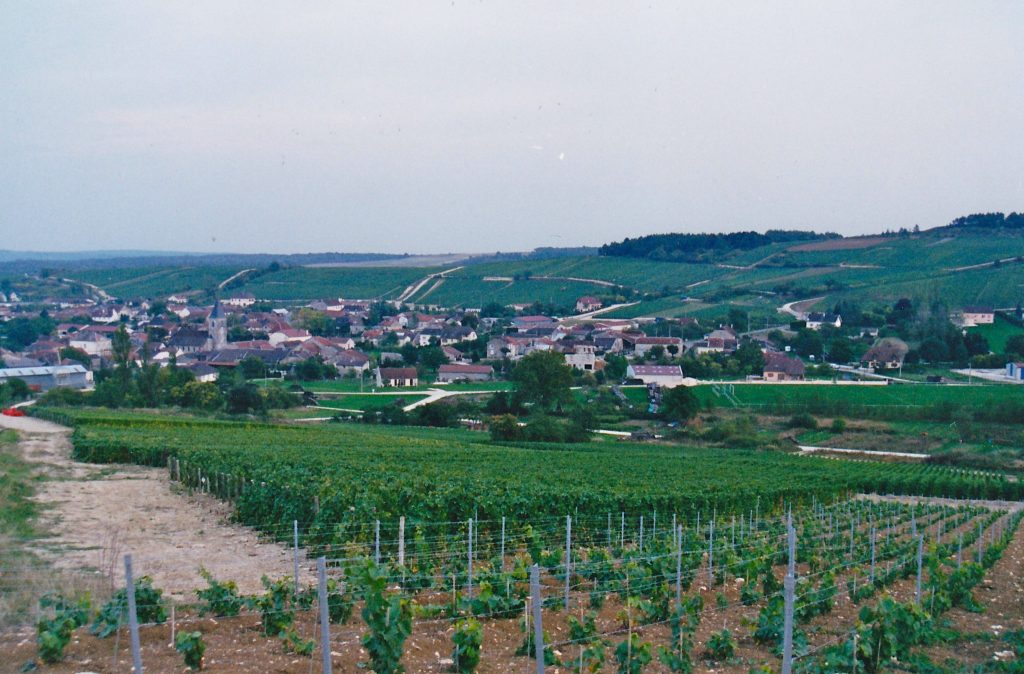
The Vineyards of the Côte des Blanc
The vintage took my school boy french to the next level. My French word of the vintage was, surprisingly not one of the top 10 trash talking words, but the word “Truc” translating roughly to Thingy. By throwing the word “Truc” into the mix with a bit of pointing and charades you can explain pretty much anything … failing that, just say what you want in English with your best, or worst, French accent and see if that works.
I’ve gotta say, having inside access to Champagne is a beautiful thing. The hospitality of the Gillet’s certainly lived up to its incredible reputation. Michelin starred restaurants, cheese, cheese and more cheese, finished off with cigars, cognac and navel gazing … AWESOME! Dinner with the Gillet’s at Parc de Villeneuve, a restaurant over the road from Devaux with a couple of Michelin Stars, ending with one of the best cheese experiences of my life! The cheese trolley (double layered, itself the size of a table for four) rolled out and a food critique from Paris, qfriend of Maree Gillet’s, organised an exceptional plate of Filthy Good Cheese. 30 cheeses laid out in a spiral, in correct eating order with a couple extra gooey ones in their own bowls to be sucked up with a straw (only kidding) at the right time … heaven. And the hits just kept rolling on, cruising around Verzenay with Claude Thibault, rocking into, his scaly mates cellars to rip the lid off a few 50 year old Champagnes with unique names like “Kiss” and “Breast”, Les Oeufs en Meurette in Reims with Roederer from Magnun. Meeting Richard Geoffrey and checking out Möet juggernaut. Heading to Dirt Bike races with Sebastien and Sophie. Life was pretty bloody good!
And then there were … just a couple of End of Vintage Parties. The Post Below was first published in Yering Station’s newsletter Assemblage in Spring 1998.
“A Grand Vintage at Devaux” by Paul Kaan
Just one week before the vintage in Champagne began it was decided that a winemaker from Yering Station would spend the northern hemisphere vintage working with our Yarrabank Joint venture partner, Devaux. Five days later Paul Kaan was on a plane. The following is his report from Bar sur Seine.
Standing in front of an Oak Fourdre for Storing Reserve Wine at Devaux
When I arrived in Paris it was cold, the sun hidden by dark clouds and the rain falling hard. One day later at Bar sur Seine in Champagne, I met Laurent Gillet, President of Devaux, and said “I thought it was summer in France but the weather is more like winter.” That night I opened my bag and gave Champagne a little gift from Australia – Sunshine.
The next day the pickers and the sunshine were out. The fruit was fantastic, the flavours delicious. Tractor after tractor arrived at the winery laden with Pinot Noir and Chardonnay. The presses marched on non-stop for fifteen days. The sun did not stop shining for two weeks. By then all of the fruit was picked and safely locked away in the winery.
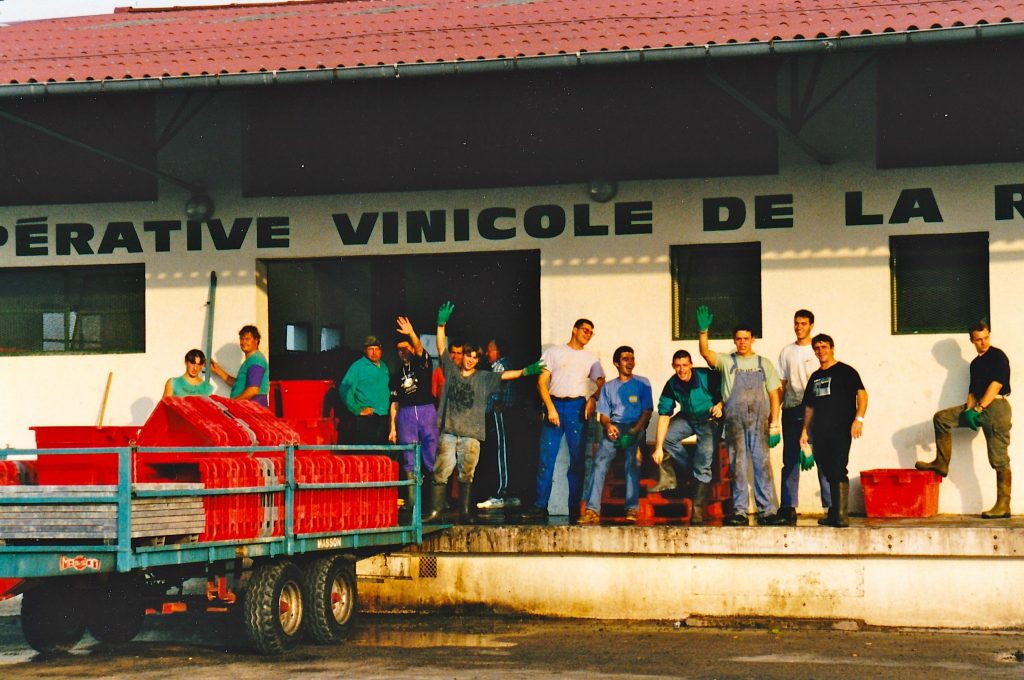
Pickers at the End of the Day – Champagne 1998
The vintage in the south of Champagne starts a little earlier than the vintage in the cooler northern regions so I had the opportunity over three weeks to work in both. In the south at Bar-o-ville and Le Ricey with Pinot Noir and in the north at Chouilly, part of the Côte des Blancs with the 100% Grand Cru Chardonnay at Legras and Haas.
The difference between France and Australia are huge. The vines are tiny, one-fourth the size of vines in Australia and the rows are so close together it is barely possible for a person to walk down the row. Bizarre tractors that look like tall crabs have been built especially to work the vineyards.
Working in different regions not only meant three very different experiences, it also meant end of vintage parties known as “Le Chien” or the dog in the south and as “Le Chochelt” or the baby pig in the north. As th only foreigner working at all the wineries the French decided that for me it was to be the BIG DOG and the HUGE PIG! After three nights of drinking a little more than my share, I had as the French say “Guele de bois” (a rough translation could be “a gigantic hangover”).
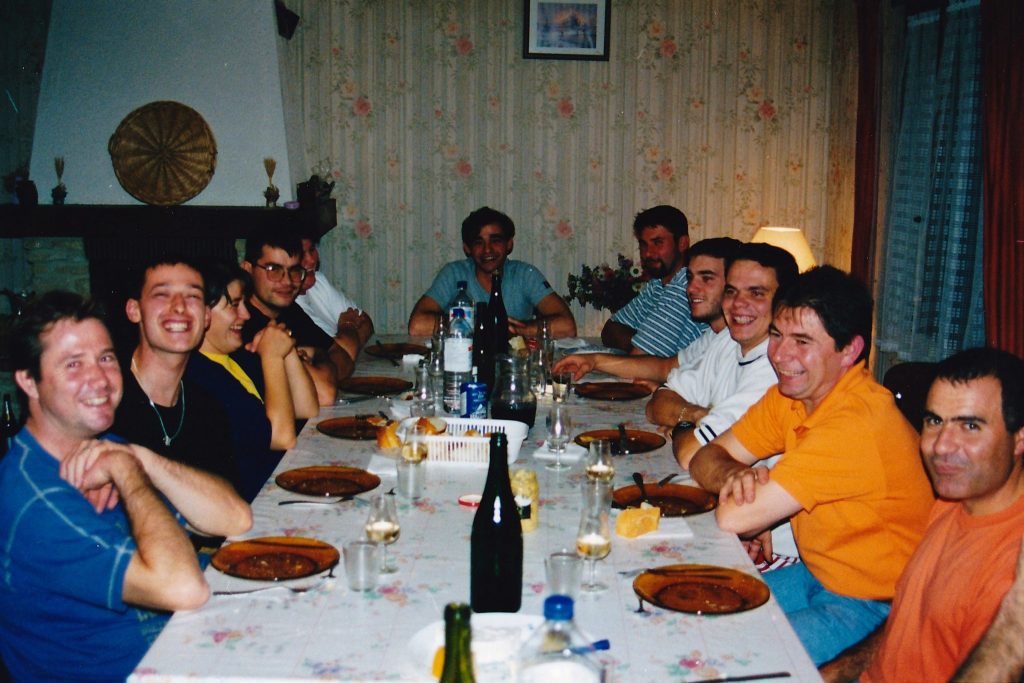
Before Shot End of Vintage Party – Champagne 1998
During Shot End of Vintage Party – Champagne 1998
After Shot End of Vintage Party – Champagne 1998
For every vintage there is “Le Chien” and every year the Champenois say the vintage is one of the best three for the century. In a few years time when the first bottles of ’98 vintage champagne arrive in Australia and we have drunk a little, or perhaps a lot, we will know.
Paul Kaan – From Champagne Devaux, Bur sur Seine, France October 1998.
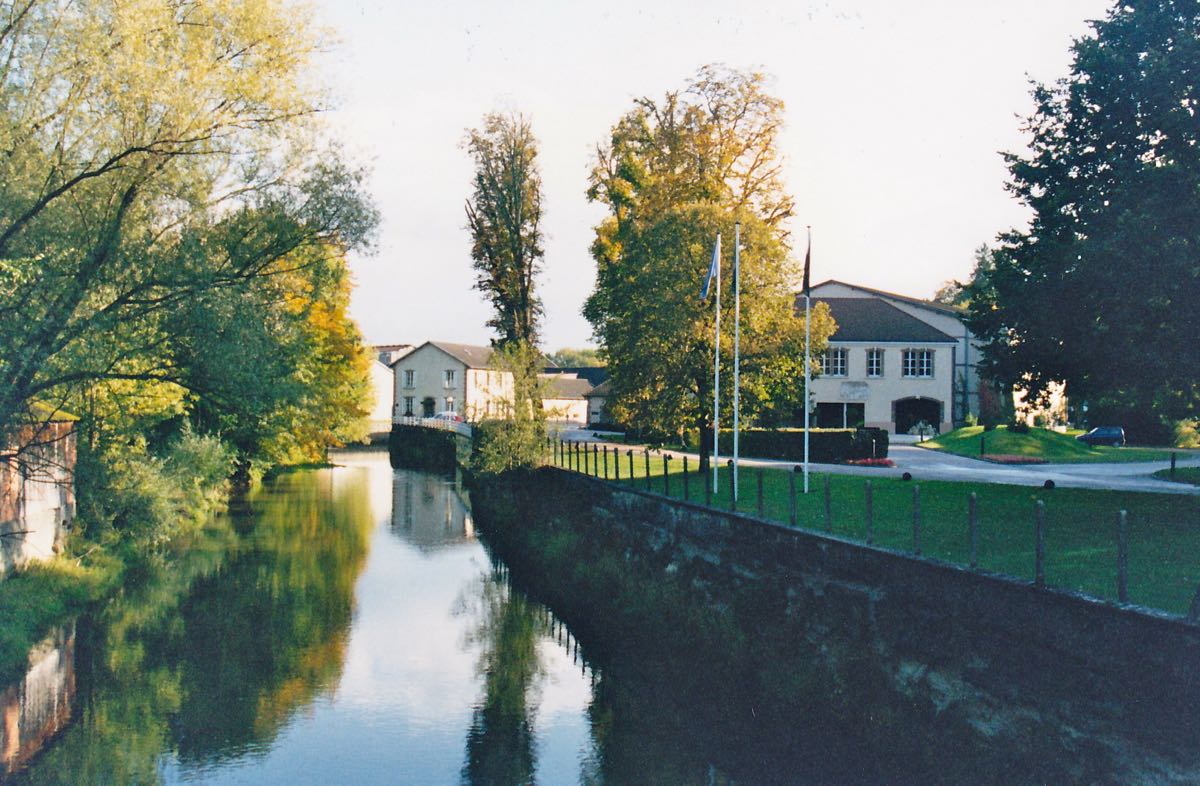
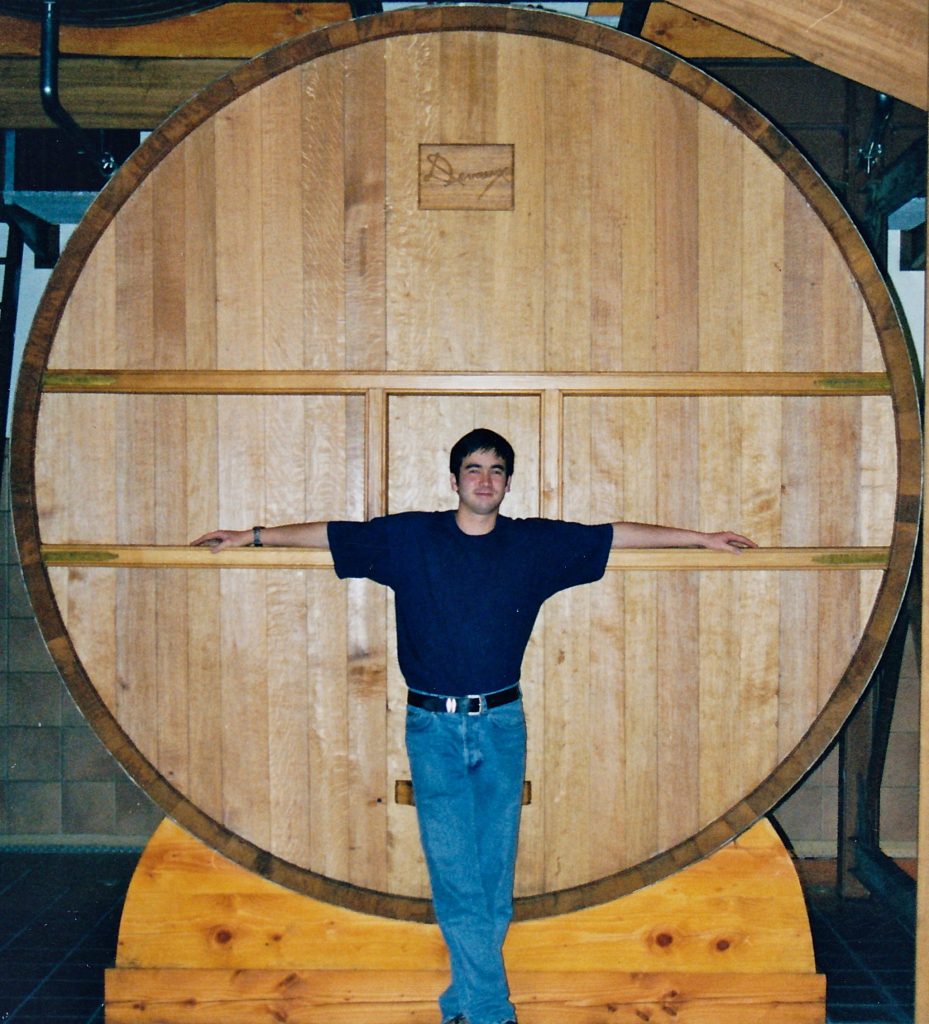
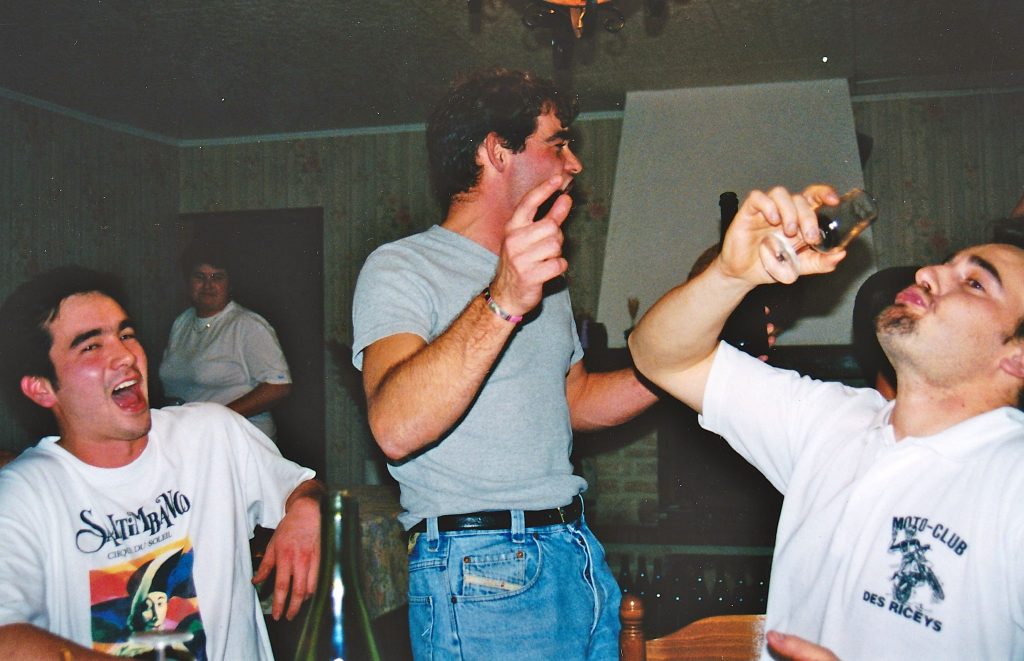
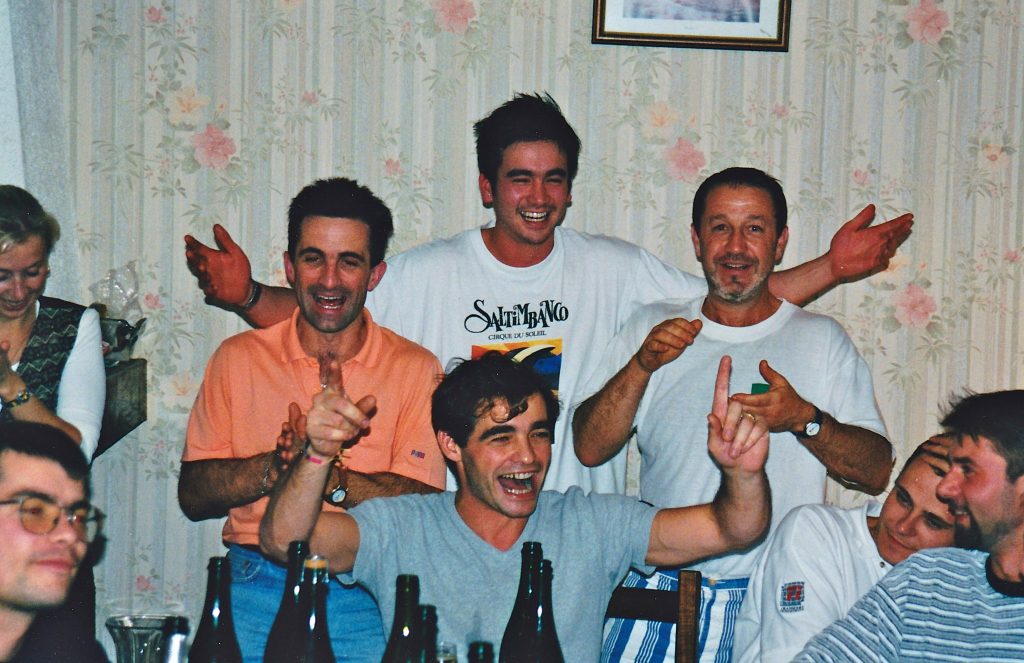
You must be logged in to post a comment.